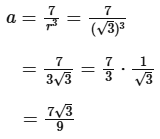The correct option is (2) 91.
Let's denote the first term of the geometric progression by a and the common ratio by r. The terms of the geometric progression can be written as follows:
First term: a
Second term: ar
Third term: (ar2)
Fourth term: (ar3)
Fifth term: (ar4)
Sixth term: (ar5)
Eighth term: (ar7)
We are given two key pieces of information:
1. The sum of the second and sixth terms is \(\frac{70}{3}\):
ar + ar5 = \(\frac{70}{3}\)
2. The product of the third and fifth terms is 49:
(ar2)⋅(ar4) = 49
a2r6 = 49
a2 = \(\frac{49}{r^5}\)
a = \(\frac{7}{r^3}\)
Substituting a = \(\frac{7}{r^3}\) into the first equation:

Multiply through by 3x to clear the denominator:
21 + 21x2 = 70x
Rearrange into a standard quadratic equation:
21x2 − 70x + 21 = 0
Divide by 7 to simplify:
3x2 − 10x + 3 = 0
Solve this quadratic equation using the quadratic formula:
\(x = {-b \pm \sqrt{b^2-4ac} \over 2a}\)
Where a = 3, b = −10, and c = 3. Thus:

Since x = r2 and r is positive, we get r = √3 or r = 1/√3. We need to choose the value that results in positive, increasing terms:
If r = √3:

Now we can determine the sum of the 4th, 6th, and 8th terms:

Adding these together:
(4th + 6th + 8th terms) = 7 + 21 + 63 = 91
Therefore, the sum of the 4th, 6th, and 8th terms is 91.